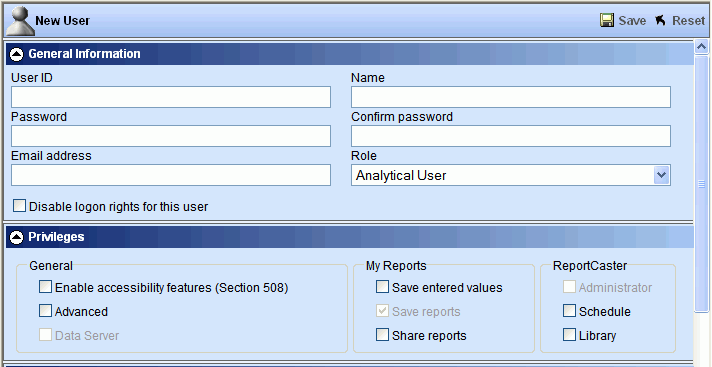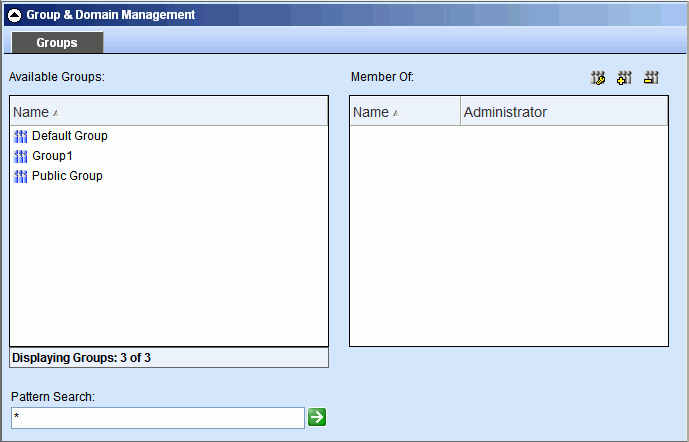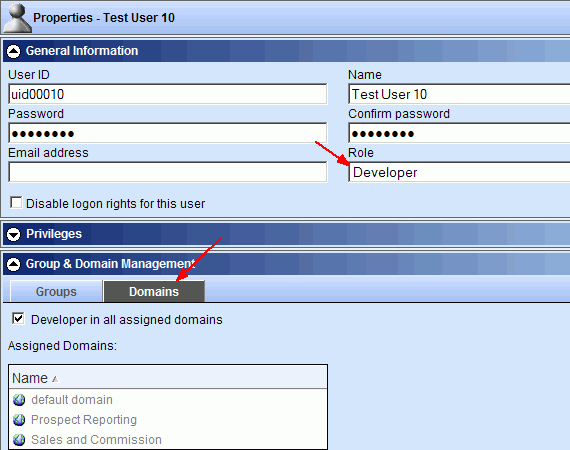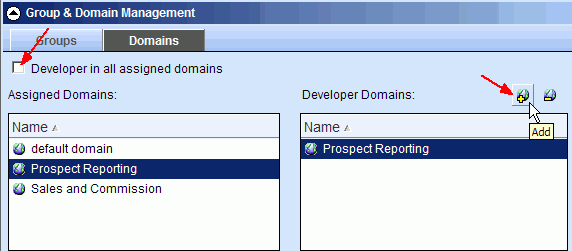In order for a user to access Managed Reporting, they must be
assigned a role and a set of privileges that define what tasks they
are allowed to perform. To access Managed Reporting application
content, the user must be a member of at least one group with one
or more domains. An exception is users with Managed Reporting administration
privileges, who always have access to all groups and domains in
the system.
The Users tab is used to create, edit, and delete Managed Reporting
users. The capabilities you have in this tab depend on your role,
as follows:
- Managed Reporting
Administrators can create, edit, and delete users.
- MR Security Object
Managers have limited access to create users and edit general information
about a user (User ID, Name, Password, Email Address, and Disable
logon rights for the user). An MR Security Object Manager is not
authorized to manage what tasks a user can perform, therefore, any
user that they create is assigned the No Privileges role by default,
which means that the user has no functional capabilities. An MR
Security Object Manager can also delete users.
- MR Group Authorization
Managers cannot create new users, but they can assign a role and
privileges to a user that is a member of a group to which the MR
Group Authorization Manager belongs, when that user does not belong
to a group that the MR Group Authorization Manager is not a member
of. In addition, a MR Group Authorization Manager can assign domains
to groups to which the MR Group Authorization Manager belongs.
- Group Administrator
Privilege have limited access to create, edit, and delete users. For
more information, see Assigning the Group Administrator Privilege.
x
Procedure: How to Create a User
-
In the
Managed Reporting Administration interface, click Users.
-
Click
the New
 button.
button.
The New User dialog box opens in the right pane. The following
image shows the General Information and Privileges options in the
New User dialog box.

-
Enter the following General Information:
User ID. The
user ID is used to log on to this user account. The User ID value
can be a maximum of 128 characters and cannot include spaces or double
quotation marks ("). You can also restrict other characters from
this field. For details, see Customizing the Interface.
You can edit the User ID value after
the account is created. This is a required property.
Name. Is the description displayed
for the user account in most areas of Managed Reporting and ReportCaster.
If you have many users, you may consider a convention such as Lastname,
Firstname for values in this field. A good naming convention makes
it easier to locate users in the lists. Name is a required property.
Password/Confirm Password. You
can assign a password for the user account or leave it blank. You
can reset the password for a user at any time. Users can also reset
their own passwords from the logon page. Password/Confirm Password
is an optional property.
Email Address. An
e-mail address is required for the Report Library, but you do not
have to include it for ReportCaster scheduling without using the
Report Library.
In certain Managed
Reporting security configurations, the Name, Email Address, Password,
and Confirm Password fields are disabled because WebFOCUS cannot update
password information stored in the external authentication directory.
For example, when you are configured to authenticate to LDAP/Active
Directory, the Password and Confirm Password fields are disabled
because an Managed Reporting Administrator cannot update your authentication
directory. Additionally, when configured for LDAP/Active Directory
authentication, RDBMS authorization, and the property USER.INFO.LOOKUP
is set to 'dual', the Name and Email Address fields are also disabled
because this user information comes from your authentication directory.
Your WebFOCUS Administrator controls these settings using the WebFOCUS
Administration Console. For more information, see Managed
Reporting Security Settings in the WebFOCUS Security
and Administration manual.
Role. Is
the type of Managed Reporting user. For details on roles, see User Roles Defined.
MR
Group Authorization Managers can only assign the role of MR Group Authorization
Manager or a lower capability role.
MR Security Object Managers
cannot edit the role of an existing user. When creating a new user,
the default role is No Privileges.
Disable logon rights for this user. Prohibits
the user from logging into Managed Reporting.
-
Assign
additional Privileges (optional).
- The MR Security Object
Manager cannot assign additional privileges and will not see this
section.
- The MR Group Authorization
Manager can assign privileges to users who belong only to those
groups that the MR Group Authorization Manager is a member. If a
user belongs to any other group, then the MR Group Authorization
Manager cannot manage them.
After
you select a role, a set of privileges is automatically assigned
to the user and cannot be changed. However, you can add additional
privileges as necessary. For details on user privileges, see User Privileges Defined.
-
Select
the groups for which you want the user to be a member.
- The MR Security Object
Manager cannot assign groups and will not see this section.
- The MR Group Authorization
Manager can assign users to groups. However, the MR Group Authorization
Manager cannot manage existing users if they belong to a group that
the MR Group Authorization Manager is not a member of.
The following images shows the
Group and Domain Management section of the New User dialog box (located
at the bottom of the pane).

To
add a user to a group, double-click the group in the Available Groups
list to move it to the Member Of list.
-
Click Save.
Note: To
modify or delete a user, in the Users tab, select a user and click
the appropriate icon.
x
The Managed Reporting Administration interface supports
the ability to search for entries by name or user ID. Large search
result sets are partitioned into a series of navigable pages to
improve performance.
In the Groups tab, you can perform pattern searches. For example,
you can enter Sa and it will return all of
the groups that begin with those two letters. In the Users tab,
you can perform pattern searches by name or user ID.
To restore your list after performing a search, click Refresh in the
browser or type an asterisk (*) in the search text box and click
the green arrow.
xAssigning the Group Administrator Privilege
A Managed Reporting Administrator can delegate some
administration responsibilities to designated users. Group administration
is a user privilege that enables users (except for No Privileges,
MR Security Object Managers, and MR Group Authorization Managers)
to manage one or more of the groups to which they belong. From the
Managed Reporting Administration interface, group administrators
can add or remove any user from the groups they administer. However,
group administrators cannot add, remove, or change the domains that
are associated with their groups.
Group Administrators can also create users and assign them roles
and privileges. However, Group Administrators cannot:
- Assign a role
higher than their own role.
- Assign a privilege
they do not possess.
- Edit existing
users if the user belongs to a group that the Group Administrator
does not administer.
Only an MR Administrator can assign the Group Administrator privilege.
It can be assigned to any user, but the privilege cannot be assigned
to a role. A user can be the Group Administrator for more than one
group and there can be multiple Group Administrators for one group.
Group Administrators use the same Managed Reporting Administration
interface that Administrators do, though the features presented
to them are limited.
x
Procedure: How to Assign the Group Administrator Privilege
-
In the
Managed Reporting Administration interface, click Users.
-
Select
the user you want to grant the administrator privilege to and click the Edit
 button.
button.
-
In Group
& Domain Management properties, select the Groups tab.
-
In the
Member of list, select the Group for which you want the user to be
the administrator.
-
Click
the Administrator
 button.
button.
An asterisk appears in the Administrator column of the
Member of list to indicate the user is the administrator of the
group.
-
Click Save.
xAssigning Development Domains
When a user is assigned the Developer role (or a role
that is based on the Developer role), the Domains tab appears in
the Group & Domain Management area of the User Properties pane.
By default, the Developer in all assigned domains check box is
selected, which means that the user is a developer for all of the
domains for which access has been granted. The domains that appear
in the Assigned Domains list are the domains the Developer is authorized
to access.

If the Developer in all assigned domains check box is not selected,
you can specify the domains in which the user can develop. The domains
listed in the Developer Domains list of the Domains tab are the
domains that the Developer user can develop in. The domains in the
Assigned Domains list of the Domains tab are the domains the Developer
is not authorized to develop content in. Within these domains, the
Developer is limited to the capabilities of the privileges they
are assigned. For example, the Developer role Save Reports as a
fixed property, which permits the Developer to create My Reports
and Share Reports, is an optional property that the Developer user
could be assigned.

xEnabling Users to Save Parameter Values
You can assign the Save Entered Values privilege to
enable users, when they run reports, to save the parameter values
they select as a My Report. The Save Entered Values privilege is
not enabled by default for any user or role. Note that the Save
Entered Values privilege is not available for the Dashboard Public
User or users assigned the No Privileges, MR Security Object Manager,
or the MR Group Authorization Manager roles.
The WebFOCUS Client amper auto-prompting feature inserts a Save
Parameters button on the form for users that have the Save Entered
Values privilege. Developers can also add the Save Parameters button
to a form from the HTML Composer. For complete details, see the WebFOCUS Managed Reporting Developer's Manual.
Note: If the report properties do not have the Prompt
for Parameters property selected, users will not see the Save Parameters
button in the Amper Autoprompting page when they run a report.
x
Procedure: How to Set Up Users to Save Parameter Values
-
Open
the Managed Reporting Administration interface.
-
For the
user or role, select the Save Entered Values privilege.
-
Click Save to
save your changes.
Note: If a user is currently logged into Managed
Reporting, the user must log off and log on again for the privilege
change to be effective.
 button.
button.


 button.
button.

